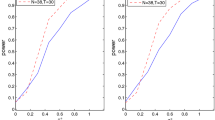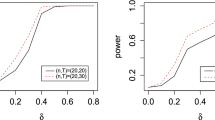Abstract
This study tests for the sandwich-form asymptotic covariance matrices entailed by conditionally heteroskedastic and/or autocorrelated regression errors or conditionally uncorrelated homoskedastic errors. In doing so, we enable the empirical researcher to estimate the asymptotic covariance matrix of the quasi-maximum likelihood estimator by supposing a possibly misspecified model for error distribution. Accordingly, we provide test methodologies by extending the approaches in Cho and White (in: Chang Y, Fomby T, Park JY (eds) Advances in econometrics: essays in honor of Peter CB Phillips. Emerald Group Publishing Limited, West Yorkshire, 2014) and Cho and Phillips (J Econ 202:45–56, 2018a) to detect the influence of heteroskedastic and/or autocorrelated regression errors on the asymptotic covariance matrix. In particular, we establish a sequential testing procedure to achieve our goal. We affirm the theory on our test statistics through simulation and apply the test statistics to energy price growth rate data for illustrative purposes; here, we also apply our test methodology to test the fully correct model hypothesis.
Similar content being viewed by others
Notes
The following URL provides the GAUSS, MATLAB, and R codes to compute the maximum test statistics and their p values for linear models: http://web.yonsei.ac.kr/jinseocho/cospimt.htm.
References
Andrews DWK (1991) Heteroskedasticity and autocorrelation consistent covariance matrix estimation. Econometrica 59:817–858
Bai X, Lam JSL (2019) A Copula-GARCH approach for analyzing dynamic conditional dependency structure between liquefied pertroleum gas freight rate, product price arbitrage and crude oil price. Energy Econ 78:412–427
Breusch TS (1978) Testing for autocorrelation in dynamic linear models. Aust Econ Pap 17:334–355
Breusch TS, Pagan AR (1979) A simple test for heteroscedasticity and random coefficient variation. Econometrica 47:1287–1294
Cho JS, Kim T-H, Shin Y (2015) Quantile cointegration in the autoregressive distributed lag modeling framework. J Econ 188:281–300
Cho JS, Phillips PCB (2018a) Pythagorean generalization of testing the equality of two symmetric positive definite matrices. J Econ 202:45–56
Cho JS, Phillips PCB (2018b) Sequentially testing polynomial model hypothesis using the power transform of regressors. J Appl Econ 33:141–159
Cho JS, White H (2011) Generalized runs tests for the IID hypothesis. J Econ 162:326–344
Cho JS, White H (2014) Testing the equality of two positive-definite matrices with application to information matrix testing. In: Chang Y, Fomby T, Park JY (eds) Advances in econometrics: essays in honor of Peter CB Phillips, vol 33. Emerald Group Publishing Limited, West Yorkshire, pp 491–556
Durbin J, Watson GS (1950) Testing for serial correlation in least squares regression, I. Biometrika 37:409–428
Durbin J, Watson GS (1951) Testing for serial correlation in least squares regression, II. Biometrika 38:159–179
Efron B, Tibsharani RJ (1988) An introduction to the bootstrap. Chapman & Hall/CRC, London
Engle R (1982) Autoregressive conditional heteroscedasticity with estimates of the variance of United Kingdom inflation. Econometrica 50:987–1008
Fan J, Liao Y, Yao J (2015) Power enhancement in high-dimensional cross-sectional tests. Econometrica 83:1497–1541
Gallant R (1987) Nonlinear statistical models. Wiley, New York
Godfrey LG (1978a) Testing against general autoregressive and moving average error models when the regressors include lagged dependent variables. Econometrica 46:1293–1301
Godfrey LG (1978b) Testing for multiplicative heteroskedasticity. J Econ 8:227–236
Golden RM, Henley SS, White H, Michael Kashner T (2013) New directions in information matrix testing: eigenspectrum tests. In: Chen X, Swanson NR (eds) Recent advances and future directions in causality, prediction, and specification analysis (Festschrift Hal White Conference). Springer, New York, pp 145–178
Golden RM, Henley SS, White H, Michael Kashner T (2016) Generalized information matrix tests for detecting model misspecification. Econometrics 4:46
Gourieroux C, Monfort A, Trognon A (1984) Pseudo maximum likelihood methods: theory. Econometrica 52:681–700
Hong Y, White H (2005) Asymptotic distribution theory for nonparametric entropy measures of serial dependence. Econometrica 73:837–901
Li Y, Yu J, Zeng T (2018) Specification tests based on MCMC output. J Econ 207:237–260
Ljung GM, Box GEP (1978) On a measure of a lack of fit in time series models. Biometrika 65:297–303
Newey WK, West KD (1987) A aimple, positive semi-definite, heteroskedasticity and autocorrelation consistent covariance matrix. Econometrica 55:703–708
Ng S, Perron P (1996) The exaxt error in estimating the spectral density at the origin. J Time Ser Anal 17:379–408
Robinson PM (1991) Consistent nonparametric entropy-based testing. Rev Econ Stud 58:437–453
Skaug H, Tjøstheim D (1996) Measures of distance between densities with applications to testing for serial independence, time series analysis in memory of E. J. Hannan. Springer, New York, pp 363–377
Wald A (1943) Tests of statistical hypotheses concerning several parameters when the number of observations is large. Trans Am Math Soc 54:426–482
White H (1980) A heteroskedasticity-consistent covariance matrix estimator and a direct test for heteroskedasticity. Econometrica 48:817–838
White H (1982) Maximum likelihood estimation of misspecified models. Econometrica 48:1–25
White H, Domowitz I (1984) Nonlinear regression with dependent observations. Econometrica 52:143–161
Wu CFJ (1986) Jacknife bootstrap and other resampling methods in regression analysis. Ann Stat 14:1261–1295
Acknowledgements
The Editor-in-Chief, Jesús López-Fidalgo, the associate editor, and two anonymous referees provided very helpful comments for which we are most grateful. The authors benefitted from discussions with the seminar participants at BIT. The responsibility for any errors and shortcomings in this work remains ours. Cho is grateful for the research Grant by the Ministry of Education in the Republic of Korea and the National Research Foundation of Korea (NRF-2018S1A5A2A01035256). Huo is grateful for the research Grant support by National Natural Science Foundation of China (No.71803009) and MOE Project of Humanities and Sciences (No. 17YJC790057).
Author information
Authors and Affiliations
Corresponding author
Additional information
Publisher's Note
Springer Nature remains neutral with regard to jurisdictional claims in published maps and institutional affiliations.
Appendix: Proofs
Appendix: Proofs
Proof of Theorem 1
For each \(i=1\) and 2, Theorem 2 of CP implies that for \(j=1\) and 2, the local alternative approximations of \(\widehat{{\mathfrak {B}}}_{j,n}^{(i)}\), \(\widehat{{\mathfrak {S}}}_{j,n}^{(i)}\), and \(\widehat{{\mathfrak {E}}}_{j,n}^{(i)}\) are equivalent and obtained as \(\frac{1}{2} \mathrm {tr}[({\mathbf {V}}_{*}^{(i)} + \sqrt{n}{\mathbf {K}}_{o,n}^{(i)})^{2}] + o_{{\mathbb {P}}}(1)\), where \({\mathbf {K}}_{o,n}^{(i)} := {\mathbf {M}}_{o,n}^{(i)} + \sum _{j=1}^{d} ( \widehat{\theta }_{j,n} - \theta _{j*} ){\mathbf {S}}_{j,*}^{(i)}\), \({\mathbf {M}}_{o,n}^{(i)} := ({\mathbf {Q}}_{*}^{(i)})^{-1}({\mathbf {Q}}_{n}^{(i)}(\varvec{\xi }_{*}) - {\mathbf {P}}_{n}^{(i)}(\varvec{\xi }_{*}) - {\mathbf {Q}}_{*n}^{(i)} + {\mathbf {P}}_{*n}^{(i)})\), and \({\mathbf {S}}_{j*}^{(i)} := ({\mathbf {P}}_{*}^{(i)})^{-1} [{\partial }/({\partial \theta _{j}}) {\mathbf {Q}}^{(i)}(\varvec{\xi }_{*}) - {\partial }/({\partial \theta _{j}}) {\mathbf {P}}_{*}^{(i)}(\varvec{\xi }_{*})]\). Furthermore, the symmetry between \({\mathbf {P}}_{*}^{(i)}\) and \({\mathbf {Q}}_{*}^{(i)}\) implies that for \(j=1, 2\), the local alternative approximations of \(\widetilde{{\mathfrak {B}}}_{j,n}^{(i)}\), \(\widetilde{{\mathfrak {S}}}_{j,n}^{(i)}\), and \(\widetilde{{\mathfrak {E}}}_{j,n}^{(i)}\) are equivalently obtained as \(\frac{1}{2} \mathrm {tr}[(\widetilde{{\mathbf {V}}}_{*}^{(i)} + \sqrt{n}\widetilde{{\mathbf {K}}}_{o,n}^{(i)})^{2}] + o_{{\mathbb {P}}}(1)\), where \(\widetilde{{\mathbf {V}}}_{*}^{(i)} := ({\mathbf {P}}_{*}^{(i)})^{-1} {\bar{{\mathbf {P}}}}_{*}^{(i)} - ({\mathbf {Q}}_{*}^{(i)})^{-1} {\bar{{\mathbf {Q}}}}_{*}^{(i)}\), \(\widetilde{{\mathbf {K}}}_{o,n}^{(i)} := \widetilde{{\mathbf {M}}}_{o,n}^{(i)} + \sum _{j=1}^{d} ( \widehat{\theta }_{j,n} - \theta _{j*} ) \widetilde{{\mathbf {S}}}_{j,*}\), \(\widetilde{{\mathbf {M}}}_{o,n}^{(i)} := ({\mathbf {P}}_{*}^{(i)})^{-1} ({\mathbf {P}}_{n}^{(i)}(\varvec{\xi }_{*}) - {\mathbf {Q}}_{n}^{(i)}(\varvec{\xi }_{*}) - {\mathbf {P}}_{*n}^{(i)} + {\mathbf {Q}}_{*n}^{(i)})\), and \(\widetilde{{\mathbf {S}}}_{j*}^{(i)} := ({\mathbf {Q}}_{*}^{(i)})^{-1} [ {\partial }/({\partial \theta _{j}}) {\mathbf {P}}_{*}^{(i)}(\varvec{\xi }_{*}) - {\partial }/({\partial \theta _{j}}) {\mathbf {Q}}^{(i)}(\varvec{\xi }_{*}) ]\). That is, \({\mathbf {V}}_{*}^{(i)} = -\widetilde{{\mathbf {V}}}_{*}^{(i)}\) and \({\mathbf {K}}_{o,n}^{(i)} = -{\mathbf {K}}_{o,n}^{(i)}\), so that for \(j=1\) and 2, the local alternative approximations of \(\widehat{{\mathfrak {B}}}_{j,n}^{(i)}\), \(\widehat{{\mathfrak {S}}}_{j,n}^{(i)}\), and \(\widehat{{\mathfrak {E}}}_{j,n}^{(i)}\) are equivalent to the local alternative approximations of \(\widetilde{{\mathfrak {B}}}_{j,n}^{(i)}\), \(\widetilde{{\mathfrak {S}}}_{j,n}^{(i)}\), and \(\widetilde{{\mathfrak {E}}}_{j,n}^{(i)}\). Therefore, it now follows that
In addition, Corollary 1 of CP implies that \(\frac{1}{2} \mathrm {tr}[(\sqrt{n} {\mathbf {K}}_{o,n}^{(i)})^{2}] \Rightarrow \varvec{{\mathcal {Z}}}^{(i)\prime }\varvec{{\varOmega }}_{*}^{(i)} \varvec{{\mathcal {Z}}}^{(i)}\), suggesting that \(\frac{1}{2} \mathrm {tr}[({\mathbf {V}}_{*}^{(i)} + \sqrt{n}{\mathbf {K}}_{o,n}^{(i)})^{2}] \Rightarrow (\varvec{{\mathcal {Z}}}^{(i)\prime } + {\mathbf {V}}_{*}^{(i)\prime }\varvec{{\varOmega }}_{*}^{(i)-1/2}) \varvec{{\varOmega }}_{*}^{(i)} (\varvec{{\mathcal {Z}}}^{(i)} + \varvec{{\varOmega }}_{*}^{(i)-1/2} {\mathbf {V}}_{*}^{(i)})\). Note that \({\ddot{{\mathbf {V}}}}_{*}^{(i)} := \varvec{{\varOmega }}_{*}^{(i)-1/2} {\mathbf {V}}_{*}^{(i)}\), so that \(\widehat{{\mathfrak {M}}}_{n}^{(i)} \Rightarrow (\varvec{{\mathcal {Z}}}^{(i)} + {\ddot{{\mathbf {V}}}}_{*}^{(i)})'\varvec{{\varOmega }}_{*}^{(i)}(\varvec{{\mathcal {Z}}}^{(i)} + {\ddot{{\mathbf {V}}}}_{*}^{(i)})\), as desired. \(\square \)
Proof of Corollary 1
For each \(i=1\) and 2, given the null hypothesis \({\mathcal {H}}_{0}^{(i)}\), \({\bar{{\mathbf {P}}}}_{*}^{(i)} = {\bar{{\mathbf {Q}}}}_{*}^{(i)} = {\mathbf {0}}\). Therefore, Theorem 1 implies that \(\widehat{{\mathfrak {M}}}_{n}^{(i)} \Rightarrow \varvec{{\mathcal {Z}}}^{(i)\prime } \varvec{{\varOmega }}_{*}^{(i)} \varvec{{\mathcal {Z}}}^{(i)}\). \(\square \)
Proof of Theorem 2
For \(i = 1\) and 2, we first note that \(\widehat{{\mathfrak {M}}}_{n}^{(i)} = \max [ {\dot{{\mathfrak {M}}}}_{n}^{(i)}, {\ddot{{\mathfrak {M}}}}_{n}^{(i)}]\), where \({\dot{{\mathfrak {M}}}}_{n}^{(i)} := \max _{j=1,2}[\widehat{{\mathfrak {B}}}_{j,n}^{(i)}, \widehat{{\mathfrak {S}}}_{j,n}^{(i)},\) \(\widehat{{\mathfrak {E}}}_{j,n}^{(i)}]\) and \({\ddot{{\mathfrak {M}}}}_{n}^{(i)} := \max _{j=1,2}[\widetilde{{\mathfrak {B}}}_{j,n}^{(i)}, \widetilde{{\mathfrak {S}}}_{j,n}^{(i)}, \widetilde{{\mathfrak {E}}}_{j,n}^{(i)}]\). Here, the leading term of \({\dot{{\mathfrak {M}}}}_{n}^{(i)}\) is determined by \({\dot{\mu }}_{*}^{(i)} := \max _{j=1, 2}[{\dot{{\mathfrak {B}}}}_{j,*}^{(i)}, {\dot{{\mathfrak {S}}}}_{j,*}^{(i)}, {\dot{{\mathfrak {E}}}}_{j,*}^{(i)}]\), where \({\dot{{\mathfrak {B}}}}_{2*}^{(i)} := ({\dot{\delta }}_{*}^{(i)})^{2} + 2{\dot{\zeta }}_{*}^{(i)}\), \({\dot{{\mathfrak {S}}}}_{1*}^{(i)}:= ({\dot{\delta }}_{*}^{(i)})^{2} + 2{\dot{\gamma }}_{*}^{(i)}\), and \({\dot{{\mathfrak {S}}}}_{2*}^{(i)}:= ({\dot{\eta }}_{*}^{(i)})^{2} + 2{\dot{\zeta }}_{*}^{(i)}\). Here, \(({\dot{\delta }}_{*}^{(i)})^{2}\) is dominated by \(({\dot{\tau }}_{*}^{(i)})^{2}\) or \(({\dot{\eta }}_{*}^{(i)})^{2}\) from the fact that \({\dot{\delta }}_{*}^{(i)} \in [{\dot{\eta }}_{*}^{(i)}, {\dot{\tau }}_{*}^{(i)}]\) and \({\dot{\eta }}_{*}^{(i)} \ge -1\). Therefore, it now follows that \({\dot{\mu }}_{*}^{(i)} = \max [{\dot{{\mathfrak {B}}}}_{1,*}^{(i)}, {\dot{{\mathfrak {S}}}}_{2,*}^{(i)}, {\dot{{\mathfrak {E}}}}_{1,*}^{(i)}, {\dot{{\mathfrak {E}}}}_{2,*}^{(i)} ]\).
Likewise, if we let \({\ddot{\mu }}_{*}^{(i)}\) be the leading term of \({\ddot{{\mathfrak {M}}}}_{n}^{(i)}\), \({\ddot{\mu }}_{*}^{(i)} = \max [{\ddot{{\mathfrak {B}}}}_{1,*}^{(i)}, {\ddot{{\mathfrak {S}}}}_{2,*}^{(i)}, {\ddot{{\mathfrak {E}}}}_{1,*}^{(i)}, {\ddot{{\mathfrak {E}}}}_{2,*}^{(i)}]\), where \({\ddot{{\mathfrak {S}}}}_{2,*}^{(i)}:= ({\ddot{\eta }}_{*}^{(i)})^{2} + 2{\ddot{\gamma }}_{*}^{(i)}\). Therefore, it now follows that \(\mu _{*}^{(i)} = \max [{\dot{{\mathfrak {B}}}}_{1,*}^{(i)}, {\dot{{\mathfrak {S}}}}_{2,*}^{(i)}, {\dot{{\mathfrak {E}}}}_{1,*}^{(i)}, {\dot{{\mathfrak {E}}}}_{2,*}^{(i)}, {\ddot{{\mathfrak {B}}}}_{1,*}^{(i)}, {\ddot{{\mathfrak {S}}}}_{2,*}^{(i)},\) \({\ddot{{\mathfrak {E}}}}_{1,*}^{(i)}, {\ddot{{\mathfrak {E}}}}_{2,*}^{(i)}]\), and further \({\dot{{\mathfrak {S}}}}_{2,*}^{(i)} \le \max [{\dot{{\mathfrak {E}}}}_{1,*}^{(i)}, {\ddot{{\mathfrak {B}}}}_{1,*}^{(i)}]\) and \({\ddot{{\mathfrak {S}}}}_{2,*}^{(i)} \le \max [{\ddot{{\mathfrak {E}}}}_{1,*}^{(i)}, {\dot{{\mathfrak {B}}}}_{1,*}^{(i)}]\). Therefore, we can further simplify \(\mu _{*}^{(i)}\): \(\mu _{*}^{(i)} = \max [{\dot{{\mathfrak {B}}}}_{1,*}^{(i)}, {\dot{{\mathfrak {E}}}}_{1,*}^{(i)}, {\dot{{\mathfrak {E}}}}_{2,*}^{(i)},\) \( {\ddot{{\mathfrak {B}}}}_{1,*}^{(i)}, {\ddot{{\mathfrak {E}}}}_{1,*}^{(i)}, {\ddot{{\mathfrak {E}}}}_{2,*}^{(i)}]\). This completes the proof. \(\square \)
Rights and permissions
About this article
Cite this article
Huo, L., Cho, J.S. Testing for the sandwich-form covariance matrix of the quasi-maximum likelihood estimator. TEST 30, 293–317 (2021). https://doi.org/10.1007/s11749-020-00719-x
Received:
Accepted:
Published:
Issue Date:
DOI: https://doi.org/10.1007/s11749-020-00719-x
Keywords
- Information matrix equality
- Sandwich-form covariance matrix
- Heteroskedasticity-consistent covariance matrix estimator
- Heteroskedasticity and autocorrelation-consistent covariance matrix estimator




